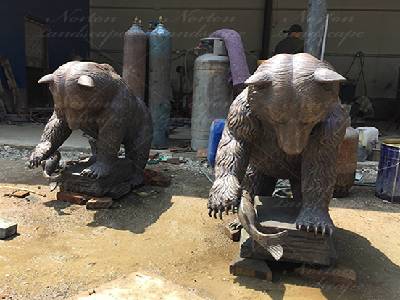Bronze Sculptures are made of bronze. Bronze is an alloy. Compared with pure copper, it has the advantages of high hardness, lower melting point, good metallic luster and corrosion resistance. It is different from traditional crafts that generally use low-priced brass. Domestic sculpture works of art will choose precious bronze as the material. The technique of bronze casting is represented by the lost wax method.
The main process of casting is: first a sculptor creates a Sculpture Model, then a series of processes are used to make a wax mold of the object to be cast from beeswax and other materials, and then a refractory material is coated on the surface of the wax mold to harden it into the outer mold of the mold. The wax is melted and flowed out to form a cavity; the core or inner vane is then made; then, the copper liquid is poured into the cavity, and the object to be cast is obtained after solidification and cooling.

1. Sculpture model: The sculptor needs to compose the picture first, and then create the prototype of the sculpture. The most commonly used sculpture prototypes are plaster and clay. The American sculptor Barry Stein uses wood as the material for his sculpture model. The sculptor decides the number of editions of bronze sculptures to be produced by himself or according to the opinions of the partners
2. Reversal mold: The factory reproduces the silicone mold based on the model created by the sculptor. From here on, it is usually a matter of the copper foundry, but most artists will also participate in quality control. The silicone mold is made by manually brushing the silicone rubber layer by layer on the model to dry, and divide it into two halves to make the silicone mold.
3. Wax filling: pour wax water in the silicone mold to form a wax shell
4. Wax repair: polish the wax shell to ensure the perfect performance of the wax model
5. Shell making: pour the slurry inside and outside the wax shell, attach the high temperature refractory patina material to the wax mold, and wait for the patina to solidify, also called shell making. The domestic production process often uses sand to make sand shells. Most of the copper casting processes in Europe and the United States have abandoned sand materials, which can make the surface of the finished bronze work smooth and free of sand holes.
6. Dewaxing and roasting: Put the wax shell after slurrying into high-temperature steam, the wax in the shell will melt and flow out when heated. There will be a space for sculpture modeling in the shell, and then the shell is heated to about 800 degrees in a roasting furnace to form a hard shell.
7. Casting: Heat the prepared copper to about 1000 degrees to melt, and cast into the shell. The formula of bronze is one of the secrets of every copper foundry's craftsmanship, and it has a direct impact on the subsequent polishing.
8. Shelling: Use a high-pressure water gun to knock down the sand shell
9. Polishing: Polish the copper billet brightly.
10. Engraving: Steyn’s works are known for their complex details, and there are many expressions of various textures on the surface. One of the most time-consuming links in the casting of his works is the processing of these details, which requires huge manual engraving. To achieve the best quality effect.
11. Welding: A large sculpture is cast in different parts, and each part needs to be welded into a whole after processing.
12. Overall polishing: The whole work is carefully polished to remove solder joints and defects.
13. Thermal coloring: The chemical high-temperature coloring is another link with the highest cost in Steyn's work. It is different from ordinary bronze works in only one color or a few colors. Steyn's works generally have dozens of color numbers and need to be colored. The craftsman repeated high-temperature coloring dozens of times.
14. Wax on the surface: The surface of the colored copper parts is sealed and protected with a protective agent to prevent oxidation and discoloration. This process is also suitable for the maintenance of sculptures at home. Without other materials, the curing wax for solid wood furniture can also be used.
Previous: Painting is Better Intellectual Development, Do You Know Why?
Next: Metal Medals Custom Souvenir Decoration Metch Gift Cheap Challenge Sports Medal
Copyright:@2020-2021
Comments Please sign in or sign up to post.
0
0 of 500 characters used